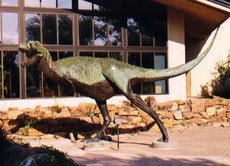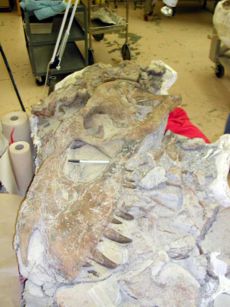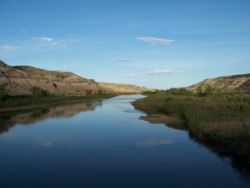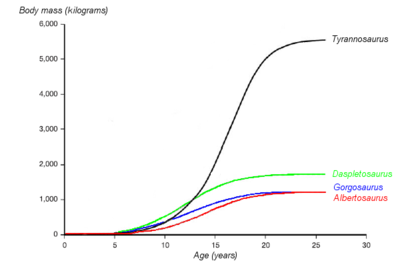Albertosaurus
2007 Schools Wikipedia Selection. Related subjects: Dinosaurs
| iAlbertosaurus |
||||||||||||||||||||
|---|---|---|---|---|---|---|---|---|---|---|---|---|---|---|---|---|---|---|---|---|
 |
||||||||||||||||||||
| Scientific classification | ||||||||||||||||||||
|
||||||||||||||||||||
|
|
||||||||||||||||||||
| Albertosaurus sarcophagus Osborn, 1905 |
||||||||||||||||||||
|
|
||||||||||||||||||||
|
|
Albertosaurus ( IPA: [æl,bɜr.toʊ'soʊr.əs]; meaning " Alberta lizard") is a genus of tyrannosaurid theropod dinosaur that lived in western North America during the Late Cretaceous Period, more than 70 million years ago. The type species, A. sarcophagus, was restricted in range to the modern-day Canadian province of Alberta, after which the genus is named. Scientists disagree on the number of species represented in the genus, recognizing either one or two species.
As a tyrannosaurid, Albertosaurus was a bipedal predator with a massive head, jaws lined with dozens of large teeth and tiny, two-fingered 'hands'. It may have been at the top of the food chain in its local ecosystem. Although relatively large for a theropod, Albertosaurus was much smaller than its more famous relative Tyrannosaurus, probably weighing only as much as a modern black rhinoceros.
Fossils of more than twenty individuals have been recovered, providing scientists with a more detailed knowledge of Albertosaurus anatomy than is available for other tyrannosaurids. The discovery of ten individuals at one site provides evidence of pack behaviour and allows studies of developmental biology which are impossible with lesser-known animals.
Description
Albertosaurus was smaller than the truly gigantic tyrannosaurids like Tarbosaurus and Tyrannosaurus. Adults measured approximately 9 m (30 ft) long. Several independent mass estimates, obtained by different methods, suggest that a full-grown Albertosaurus weighed between 1.282 tonnes (1.4 short tons) and 1.685 tonnes (1.85 short tons).
The massive skull of Albertosaurus, perched on a short, S-shaped neck, was approximately 1 m (3.3 ft) long in the largest adults. Wide openings in the skull ( fenestrae) reduced the potential weight of the head, and provided areas for muscle attachment and sensory organs. Its long jaws contained more than 60 banana-shaped teeth; larger tyrannosaurids possessed fewer teeth. Unlike most other theropods, tyrannosaurids were heterodont; the teeth took different forms depending on their position in the mouth. The premaxillary teeth at the tip of the upper jaw were much smaller than the rest, more closely packed, and D-shaped in cross section.
All tyrannosaurids, including Albertosaurus, shared a similar body appearance. Typically for a theropod, Albertosaurus was bipedal and balanced the heavy head and torso with a long tail. However, tyrannosaurid forelimbs were extremely small for their body size and retained only two digits. The hindlimbs were long and ended in a four-toed foot. The first of these digits, called the hallux, was very short and only the other three contacted the ground, with the middle digit longer than the rest.
Taxonomy
Albertosaurus was named in 1905 by Henry Fairfield Osborn of the American Museum of Natural History in a very brief note at the end of his description of Tyrannosaurus rex. The name honours Alberta, the Canadian province in which the first remains were found. The generic name also incorporates the Greek term σαυρος (sauros, meaning "lizard"), the most common suffix in dinosaur names.
Classification
Albertosaurus is a member of the theropod family Tyrannosauridae. Within this family, Albertosaurus sarcophagus is usually classified with Gorgosaurus libratus (sometimes called Albertosaurus libratus; see below) in the subfamily Albertosaurinae. Albertosaurines were more slender than the robust tyrannosaurines, the other major subfamily of tyrannosaurids. Appalachiosaurus has been called an albertosaurine in at least one study, although this is disputed.
Albertosaurus sarcophagus
The type species of Albertosaurus is A. sarcophagus, also named by Osborn in 1905. The name means "flesh-eater" and has the same etymology as the funeral container with which it shares its name: a combination of the Ancient Greek words σαρξ (sarx, meaning "flesh") and Φαγειν (phagein, meaning "to eat"). More than twenty specimens of all ages are known to science.
Gorgosaurus libratus
In 1913, paleontologist Charles Hazelius Sternberg recovered another tyrannosaurid skeleton from slightly older sediments in Alberta. This dinosaur was named Gorgosaurus libratus in 1914 by Lawrence Lambe. Finding few differences to separate the two genera, Dale Russell declared Gorgosaurus a junior synonym of Albertosaurus in 1970, creating the new combination Albertosaurus libratus. This extended the temporal range of the genus backwards by several million years and its geographic range southwards by hundreds of kilometers.
More recent examination of Albertosaurus and Gorgosaurus has cast doubt on Russell's proposed synonymy. In 2003, Phil Currie and colleagues examined skulls of the two species and came to the conclusion that the two distinct genera should be retained, although they acknowledged that the two genera are sister taxa and that the distinction is therefore rather arbitrary. However, according to Currie, Albertosaurus and Gorgosaurus are no more similar than Daspletosaurus and Tyrannosaurus, which are almost always retained as separate genera. In addition, several undescribed albertosaurine specimens have been recovered from other parts of North America, including Alaska and New Mexico, so Currie has recommended leaving the two genera separate until more of this diversity is clarified. Most authors have since followed Currie's recommendation, but some have not.
Invalid species
Other species of Albertosaurus have been named but later invalidated. William Parks described a partial skeleton from Alberta as Albertosaurus arctunguis in 1928, but this is universally considered a junior synonym of A. sarcophagus. Albertosaurus megagracilis (later renamed Dinotyrannus) was based on a small tyrannosaurid skeleton from the Hell Creek Formation of Montana in the United States. However, it is now thought to be a juvenile Tyrannosaurus.
History of discovery
The type specimen is a partial skull, collected in 1884 from an outcrop alongside the Red Deer River in Alberta. This specimen, along with an additional smaller skull and some skeletal material, was recovered by an expedition of the Geological Survey of Canada, led by the famous Canadian geologist Joseph B. Tyrrell. The specimen is now stored in the Canadian Museum of Nature. The two skulls were assigned to the existing species Laelaps incrassatus by Edward Drinker Cope in 1892. However, as early as 1877 the name Laelaps had been found to be preoccupied by a genus of mite, and it was changed to Dryptosaurus by Cope's rival, Othniel Charles Marsh. (Cope refused to recognize the new name.) Lawrence Lambe moved Laelaps incrassatus to the genus Dryptosaurus in 1904. Finally, because D. incrassatus was only based on generic tyrannosaurid teeth that could not be said to belong to any particular species, and because the Alberta skull material differed markedly from that of Dryptosaurus, Osborn named it Albertosaurus sarcophagus in 1905.
In 1910, American paleontologist Barnum Brown uncovered the remains of a large group of Albertosaurus at another quarry alongside the Red Deer River. Because of the large number of bones and the limited time available, Brown's party did not collect every specimen, but made sure to collect bones from all of the individuals present. Among many other bones deposited in the American Museum of Natural History collections in New York City, seven sets of right metatarsals were collected, along with two isolated toe bones that did not match any of the metatarsals in size. This indicates the presence of at least nine individuals in the quarry. The Royal Tyrrell Museum of Palaeontology rediscovered the site in 1997 and resumed fieldwork there. This further excavation turned up a tenth, very young individual in 2002.
The specimen originally named A. arctunguis was also excavated near the Red Deer River and is housed in the Royal Ontario Museum in Toronto, Canada. Six more skulls and skeletons have since been discovered in Alberta and are housed in other Canadian museums.
All identifiable fossils of Albertosaurus sarcophagus are known from the Horseshoe Canyon Formation in Alberta. This formation dates to the early Maastrichtian stage of the Late Cretaceous period, 70 to 73 million years ago. Many other dinosaurs have been found there, including smaller theropods like Ornithomimus, Chirostenotes and several dromaeosaurids, and a wide variety of herbivores like ankylosaurians, ceratopsians, pachycephalosaurs and hadrosaurids. Fossils of Albertosaurus have also been reported from the American states of Montana, New Mexico, and Wyoming, but these probably do not represent A. sarcophagus and may not even belong to the Albertosaurus genus.
Paleobiology
Like many tyrannosaurids, Albertosaurus is well known from several different specimens, allowing detailed studies of its life history and providing evidence of its behaviour.
Growth pattern
Most age categories of Albertosaurus are represented in the fossil record. Using bone histology, the age of an individual animal at the time of death can often be determined, allowing growth rates to be estimated and compared to other species. The youngest known Albertosaurus is a two-year-old, recently found in the re-opened bonebed quarry, and would have weighed about 50 kg (110 lb). A 24-year-old specimen from the collection of the Royal Tyrrell Museum of Palaeontology is the oldest known, weighing approximately 1.14 tonnes (1.25 tons), although the largest is a 1.28-tonne (1.4-ton) individual in the American Museum of Natural History collection. This specimen is estimated to have been 22 years old when it died. When specimens of intermediate age and size are considered, an S-shaped growth curve results, with the most rapid growth occurring in a four-year period ending around the sixteenth year of life, as seen in other tyrannosaurids. The growth rate during this phase was 122 kg (268 lb) per year. Other, similarly-sized tyrannosaurids showed a similar growth rate, but the rate is much lower than that of Tyrannosaurus, which grew almost eight times faster (767 kg [1687 lb] per year) during its growth phase. At about 16 years of age, skeletal maturity—marked by the end of the rapid growth phase—appears to have arrived in Albertosaurus, although growth continued at a slower rate throughout the animals' lives.
Pack behaviour
The Albertosaurus bonebed discovered by Barnum Brown and his crew contains the remains of at least 10 individuals. This group seems to be composed of two or three full-grown individuals over 21 years of age; one younger adult about 17 years old; four sub-adults undergoing their rapid growth phases at between 12 and 16 years old; and a ten-year-old juvenile, who had not yet reached the growth phase. A very young juvenile estimated at around two years of age was also present.
The near-absence of herbivore remains and the similar state of preservation between the many individuals at the Albertosaurus bonebed quarry led Currie to conclude that the locality was not a predator trap like the La Brea Tar Pits in California, and that all of the preserved animals died at the same time, providing evidence of pack behaviour. Other scientists are skeptical, observing that the animals may have been driven together by flood conditions or for other reasons.
There is abundant evidence for gregarious behaviour among herbivorous dinosaurs, including ceratopsians and hadrosaurs. However, only rarely are so many dinosaurian predators found at the same site. Small theropods like Coelophysis bauri, Deinonychus antirrhopus, and Megapnosaurus (Syntarsus) rhodesiensis have been found in aggregations, as have larger predators like Allosaurus fragilis and Mapusaurus roseae. There is some evidence of gregarious behaviour in other tyrannosaurids as well. Fragmentary remains of smaller individuals were found alongside "Sue," the Tyrannosaurus rex mounted in the Field Museum of Natural History in Chicago. A bonebed in the Two Medicine Formation of Montana contains at least three specimens of an unnamed species of Daspletosaurus, preserved alongside several hadrosaurs. These findings may corroborate the evidence for social behaviour in Albertosaurus, although some or all of the above localities may represent temporary or unnatural aggregations.
Currie also offers speculation on the pack-hunting habits of Albertosaurus. The leg proportions of the smaller individuals were comparable to those of ornithomimids, which were probably among the fastest dinosaurs. Younger Albertosaurus were probably equally fleet-footed, or at least faster than their prey, which may have included ceratopsians and hadrosaurs. Currie hypothesized that the younger members of the pack may have been responsible for driving their prey towards the adults, who were larger and more powerful, but also slower. However, as the preservation of behaviour in the fossil record is exceedingly rare, this idea cannot readily be tested.


